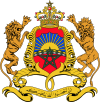Saadi Sultanate السعديون (Arabic) | |||||||||||||||||
|---|---|---|---|---|---|---|---|---|---|---|---|---|---|---|---|---|---|
| 1510–1659 | |||||||||||||||||
![Extent of the Saadian empire at the beginning of the 17th century[1]](http://upload.wikimedia.org/wikipedia/commons/thumb/e/e5/Saadiens_-_Carte_fin_XVIe_si%C3%A8cle_%28revised%29.jpg/250px-Saadiens_-_Carte_fin_XVIe_si%C3%A8cle_%28revised%29.jpg) Extent of the Saadian empire at the beginning of the 17th century[1] | |||||||||||||||||
| Status | Ruling dynasty of Morocco | ||||||||||||||||
| Capital | |||||||||||||||||
| Common languages | Arabic, Berber languages | ||||||||||||||||
| Religion | Sunni Islam | ||||||||||||||||
| Government | Monarchy (Sultanate) | ||||||||||||||||
| Sultan | |||||||||||||||||
• 1510–1517 | Muhammad al-Qa'im | ||||||||||||||||
• 1655–1659 | Ahmad al-Abbas | ||||||||||||||||
| History | |||||||||||||||||
• Established | 1510 | ||||||||||||||||
| 1541 | |||||||||||||||||
| 1554 | |||||||||||||||||
| 1578 | |||||||||||||||||
| 1591 | |||||||||||||||||
• Disestablished | 1659 | ||||||||||||||||
| Currency | Dinar | ||||||||||||||||
| |||||||||||||||||
| History of Morocco |
|---|
 |
| Historical Arab states and dynasties |
|---|
 |
The Saadi Sultanate[a] (Arabic: السعديون, romanized: as-saʿdiyyūn), also known as the Sharifian Sultanate (Arabic: السلطنة الشريفة),[6] was a state which ruled present-day Morocco and parts of Northwest Africa in the 16th and 17th centuries. It was led by the Saadi dynasty, an Arab Sharifian dynasty.[7][8][9]
The dynasty's rise to power started in 1510, when Muhammad al-Qa'im was declared leader of the tribes of the Sous valley in southern Morocco in their resistance against the Portuguese who occupied Agadir and other coastal cities. Al-Qai'm's son, Ahmad al-Araj, secured control of Marrakesh by 1525 and, after a period of rivalry, his brother Muhammad al-Shaykh captured Agadir from the Portuguese and eventually captured Fez from the Wattasids, securing control over nearly all of Morocco. After Muhammad al-Shaykh's assassination by the Ottomans in 1557 his son Abdallah al-Ghalib enjoyed a relatively peaceful reign. His successors, however, fought with each other, culminating in the 1578 Battle of Ksar el-Kebir (or "Battle of the Three Kings"), where a Portuguese military intervention on behalf of Muhammad II al-Mutawakkil was thoroughly defeated by Saadian forces. In the wake of this victory, Ahmad al-Mansur became sultan and presided over the apogee of Saadian power. In the later half of his reign he launched a successful invasion of the Songhai Empire, resulting in the establishment of a Pashalik centered on Timbuktu. After Al-Mansur's death in 1603, however, his sons fought a long internecine conflict for succession which divided the country and undermined the dynasty's power and prestige. While the Saadian realm was reunified at the end of the conflict in 1627, new factions in the region rose to challenge Saadian authority. The last Saadian sultan, Ahmad al-Abbas, was assassinated in 1659, bringing the dynasty to an end. Moulay al-Rashid later conquered Marrakesh in 1668 and led the 'Alawi dynasty to establish a new sultanate over Morocco.[3][10][11]
The Saadians were an important chapter in the history of Morocco. They were the first Arab Sharifian dynasty to rule Morocco since the Idrisids, establishing a model of political-religious legitimacy which continued under the later 'Alawis, another Sharifian dynasty.[11] They successfully resisted Ottoman expansion, making Morocco the only part of North Africa to remain outside Ottoman suzerainty, but followed Ottoman example by modernizing their army and adopting gunpowder weapons.[10] During the long reign of Ahmad al-Mansur in the late 16th century, Morocco established itself as an ambitious regional power that expanded into West Africa and pursued relations with Europe, including a potential alliance with England against Spain.[3][10] The Saadians were also significant patrons of art and architecture, with Abdallah al-Ghalib and Ahmad al-Mansur both responsible for some of the most celebrated monuments of Moroccan architecture.[12][13]
- ^ Sluglett, Peter; Currie, Andrew (30 January 2015). Atlas of Islamic History. Routledge. p. 58. ISBN 978-1-317-58897-9.
- ^ Bosworth, Clifford Edmund (2004). The New Islamic Dynasties: A Chronological and Genealogical Manual. Edinburgh University Press. ISBN 978-0-7486-2137-8.
- ^ a b c Véronne, Chantal de la (2012). "Saʿdids". In Bearman, P.; Bianquis, Th.; Bosworth, C.E.; van Donzel, E.; Heinrichs, W.P. (eds.). Encyclopaedia of Islam, Second Edition. Brill.
- ^ Bouasria, Abdelilah (2015). Sufism and Politics in Morocco: Activism and Dissent. Routledge. ISBN 978-1-317-68143-4.
- ^ Akyeampong, Emmanuel Kwaku (2012). Akyeampong, Emmanuel Kwaku; Gates (Jr.), Henry Louis (eds.). Dictionary of African Biography. Oxford University Press. pp. 22, 312, and elsewhere. ISBN 978-0-19-538207-5.
- ^ Mouline, Nabil (2009). "La genèse d'un règne". Le califat imaginaire d'Ahmad al-Mansûr (in French). Presses Universitaires de France. pp. 1–53. doi:10.3917/puf.mouli.2009.01. ISBN 978-2-13-057240-4.
- ^ Greengrass, Mark (2014). Christendom Destroyed: Europe 1517-1648. Penguin Books. p. 503. ISBN 9780241005965.
- ^ Muzaffar Husain Syed; Syed Saud Akhtar; B D Usmani (2011). Concise History of Islam. Vij Books India Pvt Ltd. p. 150. ISBN 978-93-82573-47-0. Retrieved 22 September 2017.
- ^ Abgadiyat, E. (9 May 2014). "دراسة في مضمون النقوش الكتابية على عمائر الأشراف السعديين بالمغرب الأقصى (915 - 1069هـ/ 1510 - 1658م)". Abgadiyat. 9 (1): 150–194. doi:10.1163/22138609-90000027. ISSN 2213-8609.
- ^ a b c Cite error: The named reference
:15was invoked but never defined (see the help page). - ^ a b Cite error: The named reference
:1was invoked but never defined (see the help page). - ^ Cite error: The named reference
:32was invoked but never defined (see the help page). - ^ Cite error: The named reference
:22was invoked but never defined (see the help page).
Cite error: There are <ref group=lower-alpha> tags or {{efn}} templates on this page, but the references will not show without a {{reflist|group=lower-alpha}} template or {{notelist}} template (see the help page).